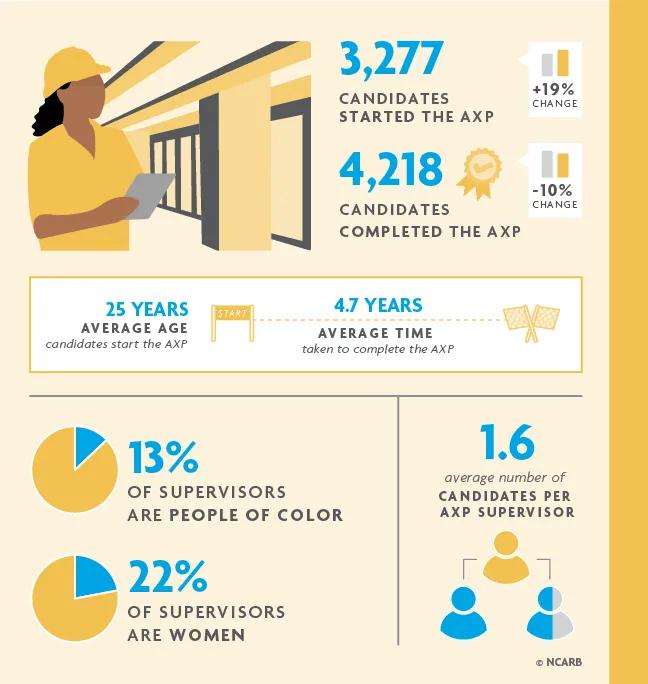
Designed to guide candidates through earning and reporting the experience needed to practice architecture competently, NCARB’s Architectural Experience Program® (AXP®) is a required component of the licensure process in almost all U.S. jurisdictions.

2021 data suggests that the COVID-19 pandemic continues to impact candidates’ AXP progress. The number of candidates starting the program increased compared to 2020’s dip, but the number of candidates completing the program saw a further decline.
Even candidates completing the program showed evidence of the pandemic’s impact, as the average length of time for competition neared five years.
Nearly 3,300 candidates started the experience program in 2021. The number of candidates beginning the AXP, which is often one of the first steps on the path to earning a license, fell dramatically in 2020 as a result of the COVID-19 pandemic.
The growth seen in 2021 signals a partial recovery from the pandemic’s impact, but the number of candidates starting the program remains significantly fewer than seen in the years leading up to the pandemic.
The number of candidates completing the experience program continued to fall in 2021—the fifth consecutive year on record.
This downward trend is being influenced by two factors. First, the launch of the AXP accelerated many candidates’ AXP progress in 2016-2017, creating a peak in the number of completions. Additionally, while AXP completions were on the decline prior to 2020, the drop seen in 2020 and the continued decrease in 2021 were likely a result of the COVID-19 pandemic, as demand for architecture services continued to fluctuate.
The average candidate who finished the experience program in 2021 took 4.7 years to do so—an increase of approximately two months compared to 2020. Time to complete the AXP has been on the rise since the program launched: 2021 candidates took six months longer on average compared to candidates who finished the program in 2017.
2021’s increase is likely a result of the COVID-19 pandemic, which saw many candidates temporarily stop submitting experience reports as they navigated the pandemic’s impact on their personal and professional lives.
Over the past five years, the proportion of candidates who complete the AXP in less than four years has steadily declined. Of candidates who completed the AXP in 2021, 38% did so in less than four years—a 7 percentage point drop compared to the proportion seen in 2017.
Of the remaining candidates, a third (33%) finished the AXP in four to six years, and 29% took six years or more. The average time to complete the program in 2021 was 4.8 years.
The average candidate who started the AXP in 2021 was 24.9 years old, and the average candidate who finished the AXP in 2021 was 29.9 years old. Both ages changed by roughly one month compared to the ages at AXP start and finish seen in 2020.
Over the past five years, the age at AXP start has dropped slightly (by approximately 4 months) while the age at AXP finish has remained the same.
Of the candidates who completed the path to licensure in 2021, 14% finished the exam before they completed their experience requirement—a four percentage point drop compared to 2020.
The gradual downward trend of candidates taking the exam prior to completing the AXP practice area is likely linked to the 2016 alignment of the AXP and ARE. The majority of candidates are choosing to complete an experience area within the AXP before attempting the related exam division.
On average, most experience reports submitted in 2021 were reviewed and approved by a supervisor within just two days of the report’s submission, the same time frame seen in 2020.
Of active AXP supervisors in 2021, 22% were women—a 1 percentage point increase compared to 2020, and a 4 percentage point increase seen over the past five years. For comparison, women make up approximately 25% of the licensed architect population, based on NCARB’s Certificate holder data. This indicates that men are more likely to be AXP supervisors than their female peers.
87% of AXP supervisors are white. Fourteen percent identify as a person of color: 1% are Hispanic or Latino, 7% are Asian, 2% are Black or African American, and 4% are a member of another group, such as Native American or Pacific Islander.
For comparison, approximately 83% of the licensed architect population is white, based on NCARB’s Certificate holder data. This indicates that white architects are more likely to be AXP supervisors compared to their peers of other racial and ethnic groups.
